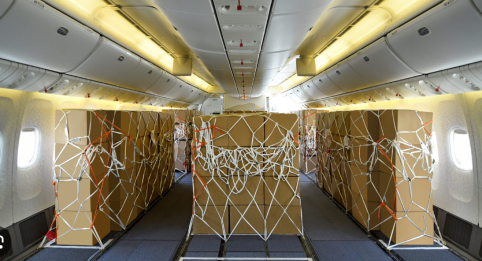Optimizing Cargo Transport in Passenger Aircraft

The utilization of passenger compartments for cargo transport has become a common practice, particularly during events like China's Spring Festival, which witnesses the largest annual migration globally. Additionally, there is a pressing need to repurpose grounded passenger aircraft effectively. Developing full-fledged Combi models for modern aircraft such as the B777, B787, and A350 XWB would require significant time, expense, and irreversible modifications. However, there are viable "combi lite" alternatives worth exploring, offering cost-effectiveness and streamlined operations without complex aircraft alterations.
Method A: Lightweight Cargo Loading Systems
During the 1970s and 80s, several B747 and DC10 operators adopted a system wherein a lightweight, non-powered cargo loading and restraint system could be installed onto the rear compartment floor of the aircraft, secured to the seat tracks. This system facilitated the use of special cargo containers, typically measuring 38 inches wide, 64 inches high, and either 61.5 or 125 inches long. Notably, this solution required minimal airframe modification and was removable within half a day, enabling swift transitions between passenger and cargo configurations.
Numerous airlines, including Alitalia, Philippine Airlines, Lufthansa, and Aer Lingus, utilized these systems, manufactured by companies like Transequip and Brooks and Perkins. Certification was achieved through STC, with examples like SA3740WE and SA 2801WE, applicable to 747-100 and -200 aircraft. These containers, with a maximum gross weight of around 800 lbs, facilitated efficient loading using main deck loaders or modified catering trucks, featuring a ball mat for seamless movement and aisle access for passengers.
Method B: ULD-based Cargo Loading Systems
An alternative approach, demonstrated by Airborne Express, involved using narrow ULDs equipped with casters, akin to galley carts, which could pass through standard passenger doors. The aircraft floor was outfitted with tracks and locks into which these ULDs were rolled and secured in place. While initially applied to narrow-bodied aircraft and later to B767F freighters, this concept could theoretically be adapted to specific zones within passenger aircraft, providing versatility in cargo transport without necessitating extensive modifications.
Both Method A and Method B, though historically employed, offer pragmatic solutions for modern challenges in cargo transport within passenger aircraft. By avoiding the complexities and costs associated with traditional Combi models, these methods enable efficient unitized cargo loading and handling, presenting viable options for contemporary air transport operations.
How Can We Help You
Welcome to CargoSecures, your trusted partner in air cargo safety. How can we tailor your order today? Specify your requirements below, from customizable aesthetics to ultra-durable nets and webbing crafted with the world’s strongest yet lightest fiber. Let's craft a solution that ensures your cargo reaches its destination securely with the least added weight.
